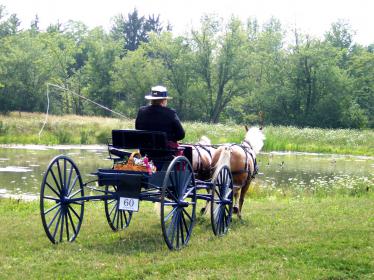There are books on carriage restoration for sale thru the Carriage Association and the American Driving Society, which both have websites.
With what you say on natural finish, cart sounds like a fairly easy project. Sand it down, then put on stain if you want a wood color change or paint for a total new look. Or just apply the protective coating to have cart stay looking the same. The stained vehicle then gets protective layers of a (usually) poly finish. Varnish works, just takes longer to dry, needs sanding smooth between a number of coats. It will yellow with time. You may need to sand for smoothness between coats of poly finish too. Painting is usually done with auto paint, mixed with a product to keep it flexible on the wood. Old car folks can be helpful in this area, painting wood and metal cars. Wood of cart will ALWAYS be reactive to local weather, humidity, by swelling and shrinking. So very hard paint crackles, flecks off sooner, can’t move with the wood. Spraying is the best application method, wear a VERY GOOD mask and check the filters often to change as needed. Paint spray in the air is fairly invisible, but breathing it in will coat your lungs, cause damage. So a good mask is a MUST with spray painting. Brush painting is possible, with sanding it smooth between coats. Just may not be as smooth as spraying. Pinstriping will set off your paint job. So practice getting lines straight, even, before doing the cart. Both wide and thin lines are acceptable. This is where books are helpful, showing traditional patterns on various style vehicles.
Witmer Coach Shop in Pennsylvania carries all kinds of parts, wheels, shafts, to replace things. Don’t keep worn or cracked shafts, singletree. Stuff wears out, not hard to replace as needed. Old wood will break under sress. Don’t take the chance of it failing when you need strength, to cause an accident with your animal. Wtimers also sell the shaft wrap leathers and trace carriers that go on shafts. They are Amish, no website, but very helpful when you call. There are many names regionally for the same part, so you have to work together sometimes to get it clear before purchasing an item.
Natural vehicles allow a more sporting type of dress, less formal kind of animal to pull it for showing. The vehicles also don’t show chips like paint can, so easier upkeep. Painted vehicles do look shiny! You are expected to dress up a bit more in them. Both vehicles let you use black harness with them.
I strongly recommend you get wheels inspected by a Wheelwright for your safety. They can be out-of-round, have lost their dish, have a rotten area that will break under stress. Rubber may need replacing. You may not even be able to spot a problem with untrained eyes. Building good wheels turn them into an engineering wonder! Doing things in motion to make travel easy. All stuff you can’t do yourself. Take pictures of nuts, washers, bearings, locking pins as you remove wheels. This helps put parts back on in the right order, prevents problems. These parts should be cleaned, degreased, have new grease put on when wheels go back on the axles. Do know that wheel hubs, hubcaps may be threaded backwards on one side. This prevents them from unscrewing during travel. So be gentle in removal, try turning them “the other way” if they don’t loosen at first.
Antique vehicles should keep the same wheel on the same side when reassembled, so mark wheels Left and Right. Do the same with their hub parts, grease cap, because they are also right and left sided only. Hubs and axles have worn to fit over time, changing wheel sides can ruin hubs and axles with new wear patterns.

